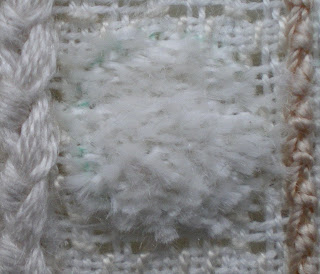Most evenings I am progressing my stitched samplers for Sumptuous Surfaces. The course has concluded now but I am still working on Lesson 2, such is the content and inspiration of Sharon's course notes.
Over the past week or so I have been working on a stripped design, aiming to fill each vertical stripe with a different texture, some low relief and some more textured. At the moment, I am particularly fascinated by pulled work, so these have featured heavily.

The area on the left is filled with satin stitch worked in a zig-zag pattern over a 2, 3, 4, 5 or 6 threads, #8 cotton perle. Actually, I am a little pleased with this bit. Random usually terrifies me, but for once, I just went with it, rather than trying to work out a random pattern.
To the right is cobbler filling, also worked in #8 cotton perle. Nothing random here, a straight forward pattern.

These two areas are seperated by a row of Portuguese Stem Stitch worked in 12 strands of Soie Cristale. Sharon had commented on an earlier sample of this stitch that it worked well in thicker threads, so I decided to give it a go. I agree, the thicker thread shows the stitch of well.

I enjoyed working the zig-zag satin stitched so decided to try it again, this time in a regular pattern over 6 threads, again in #8 cotton perle. I really like the pattern created in the fabric.

Next, I worked a stripe in four sided stitch. Again, this is a regular pattern and it creates a lovely texture. These 2 stripes are seperated by a line of heavey chain, stitched in Mulberry Silk.
From a question posed in the class forum, and rereading the instructions, I realised that my earlier attempts at Portuguese Stem Stitch were not stitched correctly (although I like them as they are) so I tried again, wrapping the stitch twice as per the instructions, rather than once, as I had done previously.

I worked two rows, one going up and one down, expecting to get a mirrored effect, but I realise now that I should have worked both rows in the same direction, but one left-handed and one right-handed. Between them I worked a row of cable stitch in a twisted rayon.
Happy stitching

















